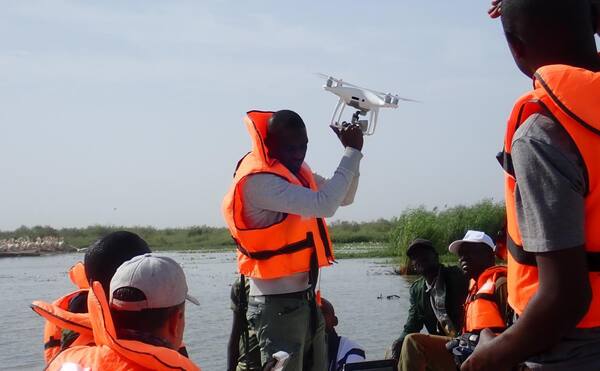Projet de renforcement de la protection et de valorisation du Parc national des oiseaux du Djoudj

Objectives
The Djoudj National Bird Sanctuary was inscribed on the World Heritage List in 1981. Until 2020, its ecological monitoring was based on direct counting of fauna and avifauna by boat, vehicle and on foot. Habitats and invasive species were monitored empirically by direct observation. Furthermore, habitat mapping was carried out using low-resolution satellite images, or at unaffordable cost. This methodology did not facilitate regular monitoring of the dynamics of invasive plants, which represent a real threat to the property. Finally, the surveillance system was based on the organization of patrols and a strategic distribution of guard posts, but remained inefficient due to a lack of personnel.
The aim of this project was therefore to use a drone to acquire high-resolution aerial images for ecological monitoring (concentrations of birds and mammals and distribution of invasive aquatic plants) and to monitor the park against various infractions (poaching, illegal fishing, grazing, etc.) with real-time data and evidence (images and geo-referenced points) against offenders.
Results
The equipment (drone and accessories) was delivered in early November 2020. Both theoretical (20 hours) and practical (44 hours in the field) training for 12 Djoudj Park staff members took place from 16 to 24 November 2020, with an exam on the last day with overall high success rates. Then, from December 2020 to June 2021, 21 monitoring missions were carried out, as well as 11 bird and mammal monitoring missions and 6 missions to monitor the dynamics of invasive plants (typha).
The use of drones made some birds (dendrocygnes, terns, egrets) and mammals (warthogs and jackals) nervous, but enabled to estimate their numbers and gain a better understanding of their distribution within the park. Invasive plant monitoring has enabled to draw up vegetation maps for the park. All these data on flora and fauna allow for a better anticipation of management and monitoring measures. Moreover, the use of drones has had a deterrent effect on offenders, and the site manager pointed out that it generated significant time savings and made it possible to monitor areas difficult to access. Its only limitation is that it cannot be used in high winds, and the level of battery autonomy will require additional purchases.
For sustainability of the project, it will also be necessary to train more staff (especially as the agents are mobile) and organize additional refresher sessions to improve data conservation, processing and analysis.
In the future, some of the images collected will be shared with visitors and communities via the interpretation center as part of an enhanced public awareness and communication strategy.